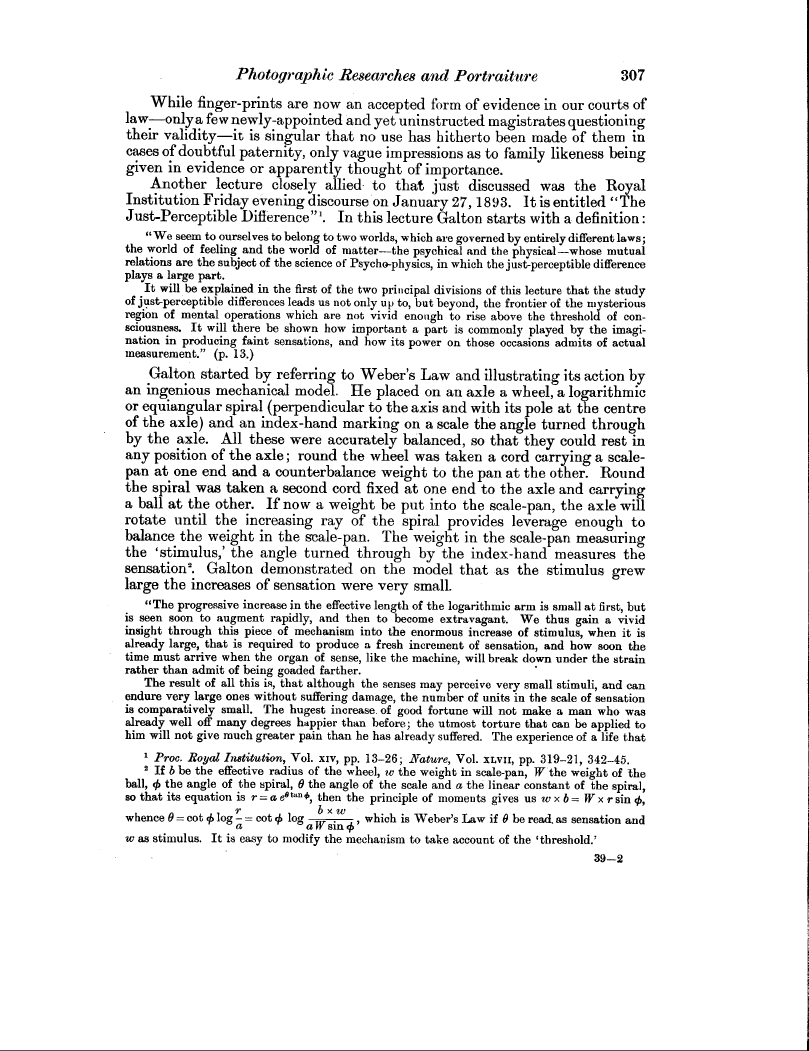Photographic Researches and Portraiture 307
While finger-prints are now an accepted form of evidence in our courts of law-onlya few newly-appointed and yet uninstructed magistrates questioning their validity-it is singular that no use has hitherto been made of them in cases of doubtful paternity, only vague impressions as to family likeness being given in evidence or apparently thought of importance.
Another lecture closely allied- to that just discussed was the Royal Institution Friday evening discourse on January 27, 1893. It is entitled "The Just-Perceptible Difference"'. In this lecture Galton starts with a definition
"We seem to ourselves to belong to two worlds, which are governed by entirely different laws; the world of feeling and the world of matter-the psychical and the physical-whose mutual relations are the subject of the science of Psycho-physics, in which the just-perceptible difference plays a large part.
It will be explained in the first of the two principal divisions of this lecture that the study of just-perceptible differences leads us not only up to, but beyond, the frontier of the mysterious region of mental operations which are not vivid enough to rise above the threshold of consciousness. It will there be shown how important a part is commonly played by the imagination in producing faint sensations, and how its power on those occasions admits of actual measurement." (p. 13.)
Galton started by referring to Weber's Law and illustrating its action by an ingenious mechanical model. He placed on an axle a wheel, a logarithmic or equiangular spiral (perpendicular to the axis and with its pole at the centre of the axle) and an index-hand marking on a scale the angle turned through by the axle. All these were accurately balanced, so that they could rest in any position of the axle ; round the wheel was taken a cord carrying a scalepan at one end and a counterbalance weight to the pan at the other. Round the spiral was taken a second cord fixed at one end to the axle and carrying a ball at the other. If now a weight be put into the scale-pan, the axle will rotate until the increasing ray of the spiral provides leverage enough to balance the weight in the scale-pan. The weight in the scale-pan measuring the `stimulus,' the angle turned through by the index-hand measures the sensation 2. Galton demonstrated on the model that as the stimulus grew large the increases of sensation were very small.
"The progressive increase in the effective length of the logarithmic arm is small at first, but is seen soon to augment rapidly, and then to become extravagant. We thus gain a vivid insight through this piece of mechanism into the enormous increase of stimulus, when it is already large, that is required to produce a fresh increment of sensation, and how soon the time must arrive when the organ of sense, like the machine, will break down under the strain rather than admit of being goaded farther.
The result of all this is, that although the senses may perceive very small stimuli, and can endure very large ones without suffering damage, the number of units in the scale of sensation is comparatively small. The hugest increase. of good fortune will not make a man who was already well off many degrees happier than before; the utmost torture that can be applied to him will not give much greater pain than he has already suffered. The experience of a life that
1 Proc. Royal Institution, Vol. xiv, pp. 13-26; Nature, Vol. xLvir, pp. 319-21, 342-45.
2 If b be the effective radius of the wheel, w the weight in scale-pan, W the weight of the ball, 0 the angle of the spiral, 0 the angle of the scale and a the linear constant of the spiral, so that its equation is r=a e"a"O, then the principle of moments gives us w x b= W x rsin 0, whence 8 = cot o log a = cot o log a W sin SS'
which is Weber's Law if 0 be read as sensation and
w as stimulus. It is easy to modify the mechanism to take account of the `threshold.' 39-2

